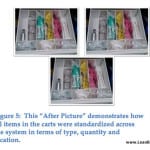 Today's post is a case study submitted by Abdul N. Mansour, Director Lean & Process Improvement at Scottsdale (AZ) Healthcare. The material here and the PDF downloads are shared with his permission.
Today's post is a case study submitted by Abdul N. Mansour, Director Lean & Process Improvement at Scottsdale (AZ) Healthcare. The material here and the PDF downloads are shared with his permission.
This project is a noteworthy story in that they were able to gain agreement of the anesthesiologists and staff across five sites and a total of 62 operating rooms, standardizing the carts for the sake of maximizing patient safety and reducing time spent searching for supplies. Click on the photo at left for a larger view of an “after” photo of standardized drawer.
It can often be tough to gain agreement and consensus on standardizing a single room or a single area used by a small team. Creating this across multiple sites is quite an impressive leadership and change management feat.
Here is the case study: Anesthesia cart article aug.3.2011 (PDF)
Here is a separate A3 document that's embedded in the case: A3 Anesthesia Carts June 30.2011 (PDF)
Some highlights from the case study (direct quotes in italics):
An anesthesiologist commented before the project: “Every cart in every room in every site is set up differently and we always have to search for items, and there are always items in the carts that we rarely use.”
This searching can introduce unnecessary risks to patient care as well as frustration to the healthcare professionals.
Highlights of some of the approaches and Lean methods used:
- The 3 Actuals:
- 1) Talking to the actual people who work in the process,
- 2) visiting the actual places where the processes take place, and
- 3) observing the actual processes
- Process mapping the current processes by following the 7 types of flows: Patient, Provider, Medication, Supplies, Information, Equipment and Processes
- Identifying the eight types of waste: Over Processing, Correction, Inventory, Wait, Search, Space and Complexity
- Developing the A3: Figure 1
- 5S: Sort, Simplify, Sweep, Standardize and Sustain
- Measurement: Baseline data, post-implementation data and pictures before and after
- Spaghetti Diagram: Observing and recording the physical movements of staff when they want to retrieve medications and supplies
Feedback from an anesthesiologist after the improvements:
Joseph J. Sandor, MD, an anesthesiologist and medical director of Scottsdale Healthcare's Piper Surgery Center said, “Standardization of the anesthesia carts, including Pyxis access for drug access in every operating room, is proving to save time and expense to the system. From the perspective of an anesthesiologist moving from one anesthetizing location to another within the hospital, the consistencies in the anesthesia machines and carts creates a significantly higher level of safety for the patients we are asked to provide anesthesia for.”
Some specific results of the anesthesia cart standardization project include:
- 80+ percent reductions in medication discrepancies between used and recorded
- Physician and staff satisfaction was very obvious, with reduced need to walk by an average of 50 miles per month.
- Anesthesia physicians and technicians are happy they don't have to waste time looking in every drawer to find an item. These professionals were involved in determining the specific item to be stocked in specific drawers.
Please download and view the entire PDF document, which includes more details and lessons learned from the project, along with Abdul's contact info.
You can also leave comments here if you'd like to discuss this work and these concepts and I expect that Abdul will participate in the discussion.
Thanks to Abdul for sharing this case studying and for publishing it here. I've talked to Abdul many times over the last two years or so and we finally met in person at the recent Lean Healthcare Transformation Summit.
Coincidentally, a visit to one of the Scottsdale Healthcare facilities, back in early 2004, was my very first personal exposure to Lean healthcare – in the emergency department. I wasn't there as a patient, but rather as a “gemba visitor” as part of a local Phoenix-area Lean networking group. Some former Motorola employees had done that early work – either as employees or outside consultants, I don't know for sure. But their work piqued my interest for what eventually became a move into healthcare.
Please scroll down (or click) to post a comment. Connect with me on LinkedIn.
Let’s work together to build a culture of continuous improvement and psychological safety. If you're a leader looking to create lasting change—not just projects—I help organizations:
- Engage people at all levels in sustainable improvement
- Shift from fear of mistakes to learning from them
- Apply Lean thinking in practical, people-centered ways
Interested in coaching or a keynote talk? Let’s start a conversation.







![When Was the Last Time a Leader Around You Admitted They Were Wrong? [Poll]](https://www.leanblog.org/wp-content/uploads/2025/07/Lean-Blog-Post-Cover-Image-2025-07-01T212509.843-100x75.jpg)


Absolutely outstanding! What a terrific case study. I wonder if they will be able to follow up with information about how much time they saved, how many fewer near-misses they have. Congratulations to this group of anesthesiologists!
I can ask Abdul for follow up. It’s probably much easier to measure walking distances and time savings than near misses, something that seems notoriously hard to measure due to the underreporting that plagues most organizations. Sometimes people balk at the idea that you’re preventing/avoiding something that we’d like to think “wasn’t going to happen anyway” (I say that tongue-in-cheek).
We can somehow how measure the time saved and the gains by the fact that our OR readiness has improved to 95% of the time in one site and over 80% in another site.
Yes, it’s true that reporting and tracking near-misses is a tough one…I guess when I see leadership like this in change management, I begin to think anything is possible! Thanks for posting this, Mark. Already shared it with an anesthesiologist/lean thinker from Oklahoma. Great post, great forum.
It lways amazes me how much improvement we can get by focussing on the simple things. Simple standardization but not easy to achieve. Gaining agreement over five sites and 62 operating rooms is truly amazing!
Well done
Cheers
Yes it is amazing. The other added benefit is that we can now say “if we can do it in this difficult area we can do it in any other areas” Thanks for your comments.
Impressive article but I think the more valuable lesson for most is not the analysis part, which looks pretty straightforward, but the involvement and ownership part which is the much more difficult part.
I’m wondering, and perhaps they did this, was if individual smaller kaizens at each location starting with the findings of the study would get a higher level of ownership and sustainability.
Also how are ongoing local upgrades administered?
Yes there were several “trystorming” events to ensure proper par levels and ownership. I will not categorize them as kaizens, but as team building and ownership transfer sessions. Yes, a Lean consultant is keeping in touch with each site to see if changes and upgrade is needed. The big lesson here is that with the right approaches and preparation physicians, who are a smart group, will approve something even if it is outside their comfort zone. This project could not have been successful without the ownership of the various groups, pharmacists, physicians, pharmacy tech, OR staff, supply people and the Lean team.